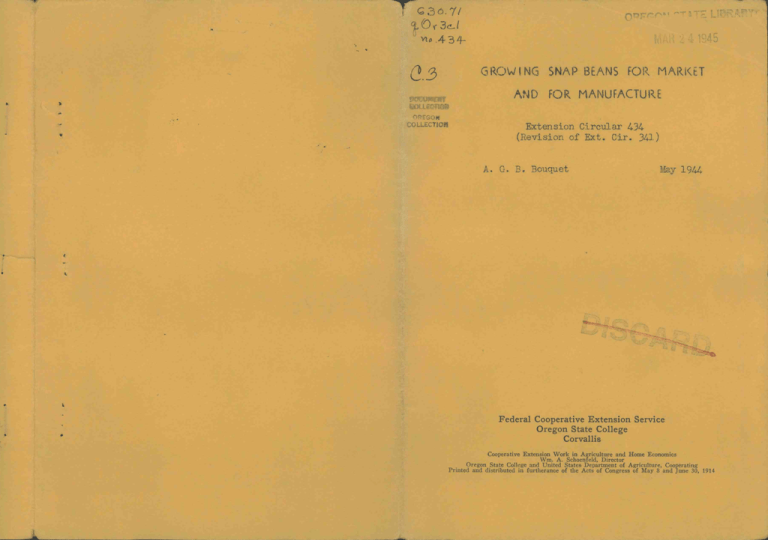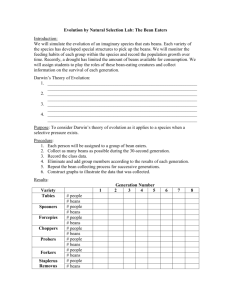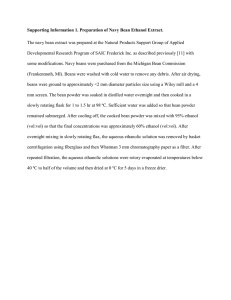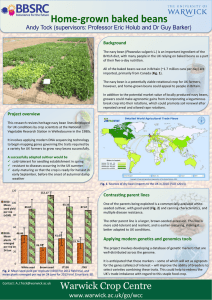Extension Circular 43/ .434- Cir. (Revision of
advertisement

.434GROWING SNAP BEANS FOR MARKET AND FOR MANUFACTURE r' G o COLLECTION Extension Circular 43/ (Revision of Ext. Cir. 3/J) A. C. B. . Bouquet May 1944 Federal Cooperative Extension Service Oregon State College Corvallis Cooperative Extension Work in Agriculture anti Home Economics Wm. A. Schoenfeld, Director Oregon State College and United States Department of Agriculture, Cooperating Printed and distributed in furtherance of the Acts of Congress of May 8 and June 30, 1914 I 4 I 1 Go.'1I ok0y3c1 OREGON STATE U5RAR' oflo P434 Extension Circular No. 434 (Revision of Extension Circular 341 May 19 COLLECTIO OREGON OLLECTO GROWING SNAP BEANS F(R MARKET AND F by A. G. B. Bouquet MANtJFACTUR The word "snap" as applied to beans is based on the development of There are the pods in that they will snap or break readily when harvested. commonly three stages of development in the bean -- snap, green-shell and The word IStrjngIi bean, sometimes used to indicate the snap stage, is dry. a misnomer as it should rightly be called "stringless." This circular considers only beans grown for the snap stage of harvesting. Importance of the crop. Snap beans are grown widely for city markets In 1943, according to statistics of the United States and for manufacture. Department of Agriculture, 176,250 acres of snap beans were grown for shipment in the United States and 154,720 acres for manufacture. In Oregon, beans are grown quit widely for canning and freezing. In 1934 only 900 acres of snap beans were grovn for processing in Oregon with an estimated valuation of 2O2,000. In 1943 approximately 4300 acres of land were planted to this crop for manufacture with an estimated tonnage of 28,800, a seasonal average price of l04.10, and a total valuation of almost three million dollars. Oregon packed 2,003,343 cases of canned snap beans In addition 8,176,943 pounds of snap beans were packed by freezing in 1943. in the Northwest in 1943. These figures of the frozen pack are for the combined states of Oregon and Washington, as there is no segregation of data for each of these two states. The acreage of beans grown in the United States for shipment in 1943 was slightly in excess of a ten-year average of 1932 to 1941, but the increase in acreage of snap beans for manufacture in 1943 was almost three times the acreage for the same ten-year period. While the acreage of beans grown for manufacture in Oregon is comparatively small compared with that in some other states, nevertheless for the past 15 years or so Oregon has led all States in tonnage per acre. The United States Department of Agriculture's statistics show that while the average yield of beans for the United States in 1943 was 1.65 tons per acre, Oregon is credited with 6.7 tons in 1943, which is somewhat higher than the 1932-1941 estimate for the State yield as a whole. The WiUamette Valley produces approximately 90 percent of the Oregon Marion county is the most important single county with about 33 percent of the State's acreage in 1943, followed by Lane county with 21 percent, the percentage basis Columbia and Multnomah county with 15 percent. county shows the greatest increase, the acreage being estimated at 290 in Small amounts of beans are grown 1943 compared with only 7 acres in 1939. in practically every county in the state. crop. 2 A variety of beans suitable for the open market and for Varieties. first, it should be manufacture should have certain definite characters: prolific in yield so as to make it profitable to the grower in tonnage; second, it should be of the correct shape, color and size in order to satisfy the trade; third, it should have good quality and flavor; and fourth, the variety should be as nearly stringless as possible. Of the tail-growing or pole varieties used for canning and freezing, Blue Lake is the most widely produced. There are several strains arid derivatives of the original Blue Lake, varying in season, growth characters, yield and degree of stringlessness. In general this variety is characterized by having moderately straight pods which are medium long, round, fleshy in character, and tender and stringless when young. Another valuable pole bean is Kentucky Wonder, which is most widely It is a v.t:orous grower and a prolific producer. grown £ or city markets. The pods are dark green and moderatei.r long arid slender, but flatter and more curved than those of Blue Lake. The quality of the Kentucky Wonder is conceded to be unexcelled and the pods stay well in the snap stage. Other valuable varieties in the pole-bean class are the striped or Both of these varieties mottled beans, Oregon Giant and Delicious Giant. produce large pods in prolific quantities. Of the bush varieties Stringless Refugee is grown most widely for manufacture. This is a productive bean, nearly round and cylindrical, having a sQmewhat light-green color. Pods are stringless and without fiber. Being borne on a low-growing plant they are more laboriously picked than the pole varieties. There are some strains of.Refugee which are considered resistant (See Diseases.) to mosaic, which is a serious disease of the bean. Other useful bush varieties are Stringless Green Pod, Tendergreen, Bountiful, Full Measure, Black Valentine, and Keystonian, a recent introduction, Wax oryellow varieties can be grown in either the bush or pole form but most of the wax beans are of the bush varieties such as Round Pod Kidney Wax and Pencil Pod Black Wax. Soils for beans. Land for growing snap beans should be well drained, moderately fertile, relatively easy to work &nd retentive of moisture or else be suitable for irrigation. Any friable land of good tilth that is naturally fertile or that has been built up to a good state of fertility will grow good yields of beans. Sandy loam and silt loam soils are preferred. In some cases beans are grown with excellent yields on organic lands that are well drained. The latter hold moisture well during the summer but the lighter lands rrnist be irrigated in order that the plants continue to bear good yields of pods. Soils that have been used for bean growing for a number of years may not continue to bear heavy yields unless the organic content of the soil Impoverished soils can be is maintained and additional fertilizer applied. detected by the meager growth of vines, the dropping of blossoms arid the small yield of pods. 3 Fertilizers. Manure or cover crops are the best materials for adding organic matter and fertility to bean soils. Where manure cannot be obtained in sufficient quantities there is usually a definite program of building up the organic matter by means of cover crops such as vetch, peas, barley, etc. Bean growers now producing high yields of beans consider the green manure In Extension Bulletin program a necessary factor in maintaining good yields. 506 directions are given regarding the type of cover crops that are grown, the number of pounds of seed to be planted, etc. Bean vines are usually plowed down in the fall preparatory to planting the seed of the cover crop and add organic matter thereby. Beans do not respond to liming unless the soil is fairly acid. grow well in a soil reaction ranging from pH 5.8 to 6.5. They Commercial fertilizers are commonly used to supplement plant food In the use of commercial fertilizer contained in manure or cover crops it. is important to consider the relative proportion of units of nitrogen, phosphoric acid and potash contained in the complete fertilizer if such is used; also the materials that are put into the fertilizer, the total amount of the fertilizer applied per acre, and the important matter of placement. Commercial fertilizers are widely used in bean growing but there are variations both in the analysis of fertilizers used and in the manner of application. Quite frequently a complete fertilizer such as 4-12-4 or 4-16-4 fertilizer is applied to one side of the seed row at time of planting, Some growers broadcast fertilizer using about 250 to 300 pounds of fertilizer. before seeding and supplement it with applications of material following the establishment of the plants and the appearance of the first pods. In view of the constant production of pods on the plants it is generally considered advisable to make supplementary applications of commercial fertilizer as the season progresses. The maximum amount of fertilizers per acre recommended by the Oregon Experiment Station for use in growing beans would be 80 pounds of nitrogen, 160 pounds of phosphoric acid, and 80 pounds of potash per acre, which would be equivalent to 1000 pounds per acre of an 8-16-8 fertilizer. This is the maximum amount of plant nutrients and not necessarily the recommended amounts. Seed and seeding. The yield and market quality of any variety of beans are very largely dependent on the particular strain of seed of the variety. The seed should come from a field that has been thoroughly rogued for plants and pods of an undesirable type. Flat bean pods are particularly It is especially important, too, that the distasteful to the processor. seed be free from mosaic and other seed-borne diseases. Bush beans are grown in continuous rows and the field is seeded with a drill seeder using approximately 60 pounds per acre. The distance between rows is usually 28 to 30 inches. The seed should not be sown too thickly as the plants will produce more and better pods If they stand a few inches apart. 4 Bean seeds are usually not treated before planting but in case they are, Spergon, at the rate of one ounce to 50 pounds of seed, seems to be the preferred material for protecting the seed from rotting. Pole beans are grown with the rows usually four feet apart and groups of plants every 24 inches or so. For this method of seeding about 20 pounds Quite comnonly a combination fertilizer distributor per acre is sufficient. and bean planter is used. Some growers use more seed and have a more or less continuous row of plants. The planting of seed of pole beans varies from early May to the middle of June, depending upon what time it is desirable to have the beans come to a stage of development for harvesting. Sometimes plantings which are delayed until the second week or so of June may miss hot weather during blossoming time but no lantings can be predicted to miss undesirably warm temperatures. Ordinarily a period of O days elapses between seeding and the first harvesting, but this varies according to weather conditions and varieties and strains used. For the home or market garden, plantings of bean seed may be made up to the middle of July or so to provide Bush beans are useful in this respect, using such varieties as a fall crop. Stringless Green Pod, Tendergreen, Pencil Pod Black Wax, or such others as the market may desire. Thinning and training. There will be no thinning in growing bush beans, and plants of pole varieties are also rarely thinned but this may depend upon the method of growing the crop. The plants persist in growing anticlockwise. In one method, stakes, There are two general methods of training pole beans. At the top of seven to eight feet long, are set in the rows two feet apart. the stakes from one to the other is tied a string on which the beans will In another method, stout run when they have reached the top of the stakes. posts are set at the ends of the rows and between them at certain intervals are set up other posts 50 feet apart to which wire is attached at the top, strings being stretched from the plants themselves to the top wire. Between the posts are placed props to hold up the wire. Some growers like this method of training the beans rather than the stake method, claiming that the pods are more readily seen when harvested. Maintenance of the bean area. Four important things in caring for an first, cultivation for weed area of land planted to snap beans include: control; second, irrigation; third, insect and disease control; fourth, supplementary soil fertilization. Cultivation. No more cultivation or soil stirring between the rows should be done than to control weeds and keep the soil in proper tilth during the growing season. Irrigation. The irrigation of a bean field is necessary for the production of a high yield of pods of good quality. Beans are usually irrigated once every ten days or so, depending upon the type of soil and weather conditions. Growers use the sprinkling method of irrigation for an Some approximate period of 60 days during which the plants are watered. fields are irrigated by the gravity system, but most pole beans are watered by the overhead sprinkling method. Many fields in areas of canning beans are watered by rotary sprinklers, the water being distributed through portable or permanent lines of pipe. From 12 to 15 inches of equivalent rainfall are usually provided an acre of beans during the watering season. 5 One grower irrigating 18 acres of Blue Lake beans pumps and distributes the water by means of a 2-inch pipe, 10-horsepower electric motor, 4-inch pipe for mains, and 2-inch pipe for laterals. This outfit operates 20 sprinklers at one time vkiich are set at a distance of 66 x 78 feet, the total number of sprinklers covering approximately two acres. These sprinklers usually run about five hours at a setting. Another grower operates with a 7-1/2 horsepower motor, a 2-inch pump, 4-inch main, and 2-inch laterals having the rotary sprinklers set at 50 x 60 feet. An efficient setup of rotary sprinklers of fairly high pressure can be obtained by spacing them at 60 x 60 feet on the diagonal. It is especially important that the soil be well supplied with moisture during the peak oI' the bean blossoming season for this may be quite a factor in preventing the young beans from shriveling. In cooler weather blossoms and pods will develop normally contrasted with possible serious withering which may occur during high temperatures. Insect control. There are several insects which do considerable damage to snap beans. First, the 12-spotted beetle is liable to do much early injury by chewing the tender leaves of the young plants soon after they come through the ground. Later on, these insects eat the leaves and pods of the plants. The pod injury is sometimes quite serious as there may be a heavy percentage of the pods with small holes eaten in them, thus rendering them unfit for open marketing or for manufacturing. When the bean plants are quite small the beetles, if not too numerous, may be held in check by using a calcium arsenate or cryolite dust. Later on, as the plants get larger and the bean leave trap pods form, experiments indicate the following to be of value: Spray rows, drive the beetle to trap rows by dusting with hydrated lime. beetles on trap rows with undiluted calcium arsenate or cryolite dust at rate of not to exceed 15 pounds per acre. There should be about S or 10 rows between the tso or three trap rows. Black aphids are sometimes very injurious, particularly to pole beans, but they usually can be controlled by spraying with Blackleaf 40 or by using nicotine sulfate dust, applying either one of these materials as soon as the In warm weather nicotine dust is very effective. Most lice first appear. of the time the aphids are on the undersides of the leaves and the spray or dust must be applied thereto. Nitidulid beetles are small black beetles resembling flea beetles but they are not nearly so active. These tiny black beetles work primarily on the floral organs but in some cases it may be suspected that damage to blossoms Dustirigs with calcIum arsenate or cryolite might occur on account of them. dust may be helpful but present experimental results are inconclusive. If seed is saved of snap beans it should be fumigated immediately after harvest with carbon bisuiphide to control the bean weevil. Symphylids are small, white, centipede-like animals which are more or less widely distributed through certain bean-growing areas. They have caused considerable damage in the past and seem to be increasing in number and in the scope of land affected, Their underground habits make them extremely difficult to control, and up to the present time there is no effective and inexpensive control measure known. Diseases. Bean Mosaics involve a complicated situation. One of them is seed-borne; the other is introduced from infected clover or bean crops by aj*xids. Resistant varieties may be resistant to one but not to the other. Disease-free seed is essential for the control of the seed-borne mosaic. Avoid planting near old clover sod to prevent the introduction of the other. Bean rust is common in bean-growing areas when weather condit1on are favorable for the development of the disease. It is a fungus disease which is liable to affect different varieties of the common bean. Vhile some varieties have proved somewhat resistant to this disease many of the popular varieties of beans, grown commercially, are seriously affected. Control of bean rust in commercial acreages will depend On: (1) Cutting down and discing in vines as soon as last picking is made to prevent formation of overwintering stage; (2) treat stakes and other equipment with dormant lime sulphur to kill any overwintering spores on them; (3) dust with sulphur dust at weekly intervals if rust was serious the year before, or if considerable rust appears on the new foliage before any bean pods begin to form. Oregon State College Circular of Information No. 331 on "Control of Bean Rust," by J. A. Milbrath, is available at offices of county agents. Blossom drop and other miscellaneous troubles. It is generally recognized that pollination of beans may be seriously affected by high temperatures. Bean blossoms drop off because of imperfect pollination due to the influence of warm weather on pollen germination. If the plants have a good reserve of moisture and leaf growth they seem to show a smaller percentage of blossom drop than otherwise. Some snap bean pods are "polliwog" shaped instead of being straight, well-filled and uniformly shaped from stem to point. "Folliwog" bean pods are thin and undeveloped of seed at or about the stem end with a more or less normal development of seed in the pod at the tip or point end. In most pods of the kind, therefore, they are half or one-third filled with seeds instead of having the normal number of five or six seeds per pod. A smooth, wellshaped pod of Blue Lake or other variety will have immature bean seeds uniformly located from end to end but a "polliwog" will be compressed at the stem end and middle, containing few or no seeds at all for the proper development of the pod. Improper or insufficient fertilization of the bean flower is a vital cause of malformed pods. ±n New Jersey where summer temperatures are commonly high it was found that pods with one bean or two in them resulted from flowers pollinated by pollen grains containing few starch grains, such pollen having a high degree of sterility. It was furthermore found that the number of beans per pod was reflected by the condition of the pollen as to whether the grains of the pollen were well or poorly supplied with starch. There are indications also that point to the size of plants and the amount of foliage growth being pa-tly responsible for drop of blossoms and malformed pods. Fields which are quite evidently producing undernourished or impoverished bean plants are apt to yield "polliwog" pods. In such cases there is a definite food shortage for supplying the vegetative growth of the plant and the production of blossoms and pods. 7 Where there is ample nutrition provided for the bean field by sufficient soil fertilization and water application and the plants are vigorous and growing well, both flover drop and malformed pods are definitely fewer in number. Harvesting and yields. The quality and market value of snap beans are very largely dependent upon the time of picking and the development of the It is important to pick beans before they become too large or the seed pods. has started to swell inside of the pod. Some varieties remain longer on the vine without deteriorating than others. However, varieties such as Blue Lake must be watched closely in order to have them harvested at the proper time. It is necessary to pick bean pods individually in order to leave on the vines those pods which are not yet large enough to be harvested but at the same time to be sure to pick those that have reached sufficient development. In this way the percentage of lower grades of beans may be reduced to a minimum. In view of the fact that the grower is paid on a graded basis, at least for beans for processing, it is necessary that there be careful, clean and thorough picking of all pods ready to be harvested at a specific time. The following are the bean pod dimensions of th field grades: No. 1 grade, 141/64 to 21/64; No. 2 grade, 24/64; No. 3 grade, 27/64. The percentages of grades in a field will vary considerably with the season, variety, soil fertility, moisture conditions, and the ability of the grower to obtain sufficient labor to harvest the crop. Yields of beans vary largely according to the variety and type of soil. The bush sorts bear about one-third the tonnage of such varieties as Blue Lake, Kentucky Wonder and other pole varieties. The latter yield from six to twelve tons per acre while the bush varieties bear up to three tons. Studies in bean harvestings would indicate the average adult's picking to be about 200 pounds per day with some pickers more than doubling that amount. In the year 1934 the seasonal average price of beans for Prices. processing was approximately 47 per ton. In 1942 the seasonal average was These are average prices for the 493.20; in 1943 approxinate1y <104.l0. three grades of beans. Acknowledgment. The author acknowledges with thanks the assistance of Drs. Don Mote, F.. P. McWhorter and J. A. Milbrath in assisting with the presentation of information dealing v.ith the control of insects and diseases of the bean plant.






